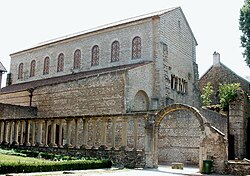You can help expand this article with text translated from the corresponding article in French. (January 2012)Click [show] for important translation instructions.
|
| Basilica of Saint-Pierre-aux-Nonnains | |
|---|---|
| Ancienne abbaye Saint-Pierre | |
église Saint-Pierre-aux-Nonnains | |
 | |
 | |
| 49°06′54″N6°10′10″E / 49.11500°N 6.16944°E | |
| Location | Metz, Moselle, Grand Est |
| Address | 1 rue de la Citadelle |
| Country | France |
| Previous denomination | Catholic |
| Website | https://metz.fr/lieux/lieu-129.php |
| History | |
| Status | Abbey church |
| Dedication | Saint Peter |
| Architecture | |
| Functional status | Deconsecrated (museum) |
| Style | Late Roman, Ottonian |
| Years built | 7th-century, 13th century, 15th–16th centuries |
| Groundbreaking | 370–400 |
| Specifications | |
| Nave length | 34 m (111 ft 7 in) |
| Nave width | 18 m (59 ft 1 in) |
| Nave height | 20 m (65 ft 7 in) |
| Materials | Stone |
| Administration | |
| Diocese | Metz |
| Official name | Ancienne abbaye Saint-Pierre |
| Type | Classé |
| Designated | 31 December 1909 |
| Reference no. | PA00106812 |
The basilica of Saint-Pierre-aux-Nonnains in Metz, France, is one of the oldest churches in Europe. The building began life in the 4th century when Metz was an important Gallo-Roman city. [1]